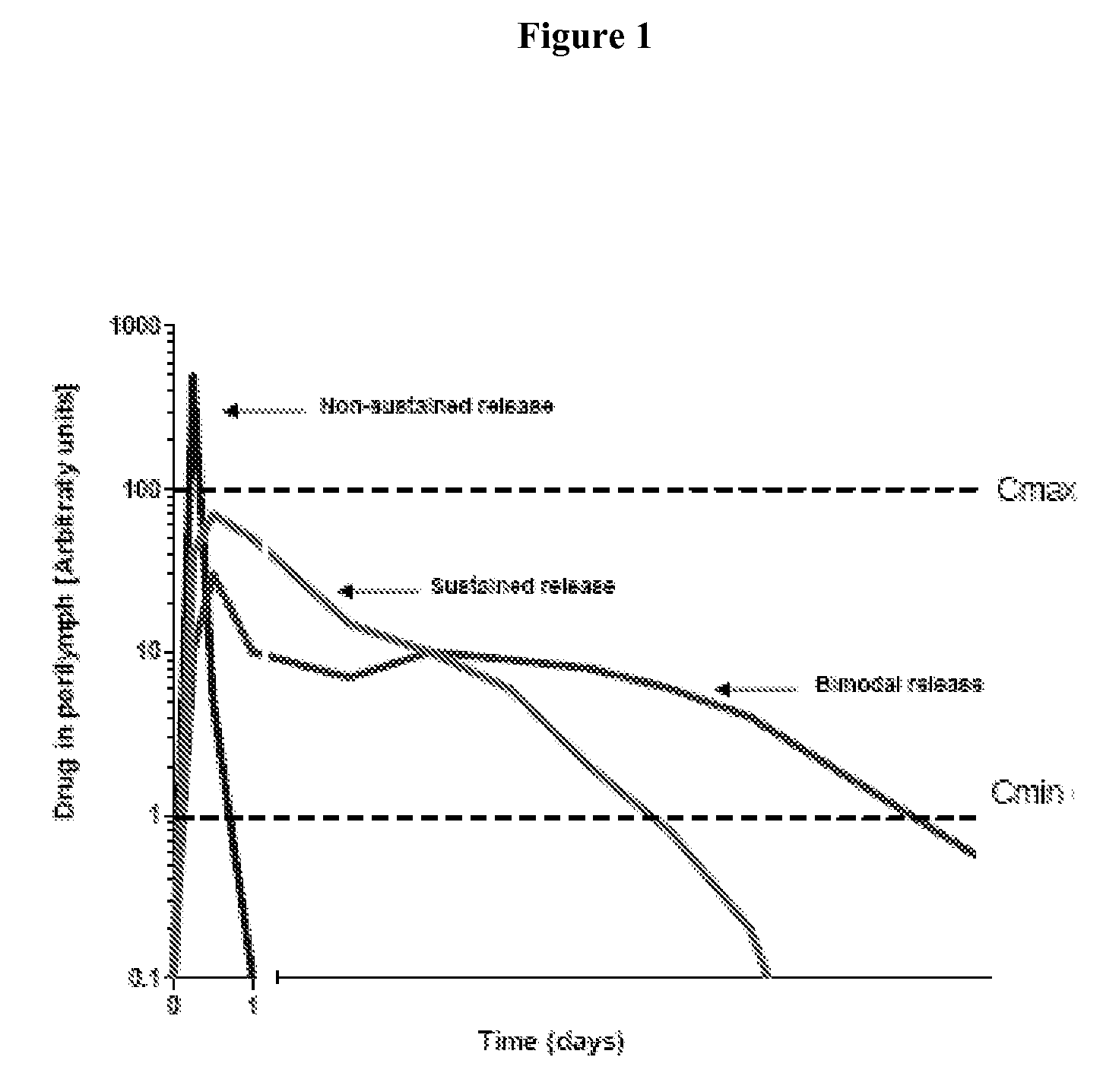Controlled-release CNS modulating compositions and methods for the treatment of otic disorders
a technology of compositions and otic disorders, applied in the direction of drug compositions, biocide, heterocyclic compound active ingredients, etc., can solve the problems of active agent delivery, loss of balance and/or osification of auditory structures, hearing loss, etc., to and reduce the frequency of administration.
- Summary
- Abstract
- Description
- Claims
- Application Information
AI Technical Summary
Benefits of technology
Problems solved by technology
Method used
Image
Examples
example 1
Preparation of a Thermoreversible Gel Diazepam Composition
[0397]
QuantityIngredient(mg / g of composition)Diazepam25.0methylparaben2.5Hypromellose25.0Poloxamer 407450.TRIS HCl buffer (0.1 M)1997.5
[0398]Diazepam is supplied in 5 mg / ml pre-filled glass syringes.
[0399]A 10-g batch of gel composition containing 1.0% of diazepam is prepared by first suspending Poloxamer 407 (BASF Corp.) in TRIS HCl buffer (0.1 M). The Poloxamer 407 and TRIS are mixed under agitation overnight at 4° C. to ensure complete dissolution of the Poloxamer 407 in the TRIS. The hypromellose, methylparaben and additional TRIS HCl buffer (0.1 M) is added. The composition is stirred until dissolution is observed. Diazepam is added and the composition is mixed until a homogenous gel is produced. The mixture is maintained below room temperature until use.
example 2
Preparation of a Mucoadhesive, Thermoreversible Gel Diazepam Composition
[0400]
QuantityIngredient(mg / g of composition)Diazepam25.0methylparaben2.5Hypromellose25.0Carbopol 934P5.0Poloxamer 407450.0TRIS HCl buffer (0.1 M)1992.5
[0401]A 10-g batch of mucoadhesive gel composition containing 1.0% of diazepam is prepared by first suspending Poloxamer 407 (BASF Corp.) and Carbopol 934P in TRIS HCl buffer (0.1 M). The Poloxamer 407, Carbopol 934P and TRIS are mixed under agitation overnight at 4° C. to ensure complete dissolution of the Poloxamer 407 and Carbopol 934P in the TRIS. The hypromellose, methylparaben and additional TRIS HCl buffer (0.1 M) is added. The composition is stirred until dissolution is observed. Diazepam is added and the composition is mixed until a homogenous gel is produced. The mixture is maintained below room temperature until use.
example 3
Preparation of a Hydrogel-Based Lidocaine Composition
[0402]
QuantityIngredient(mg / g of composition)Lidocaine HCl30.0paraffin oil600trihydroxystearate30.0cetyl dimethicon copolyol90.0waterqs ad 1000phosphate buffer pH 7.4qs pH 7.4
[0403]The cream-type composition is first prepared by gently mixing Lidocaine HCl with water. Then, the oil base is prepared by mixing paraffin oil, trihydroxystearate and cetyl dimethicon copolyol at temperatures up to 60° C. The oil base is cooled to room temperature and the Lidocaine HCl solution is added. The two phases are mixed until a homogenous, monophasic hydrogel is formed.
PUM
| Property | Measurement | Unit |
|---|---|---|
| Temperature | aaaaa | aaaaa |
| Temperature | aaaaa | aaaaa |
| Fraction | aaaaa | aaaaa |
Abstract
Description
Claims
Application Information
 Login to View More
Login to View More - R&D
- Intellectual Property
- Life Sciences
- Materials
- Tech Scout
- Unparalleled Data Quality
- Higher Quality Content
- 60% Fewer Hallucinations
Browse by: Latest US Patents, China's latest patents, Technical Efficacy Thesaurus, Application Domain, Technology Topic, Popular Technical Reports.
© 2025 PatSnap. All rights reserved.Legal|Privacy policy|Modern Slavery Act Transparency Statement|Sitemap|About US| Contact US: help@patsnap.com



